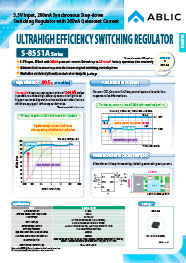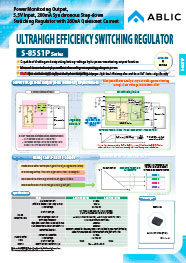Where the problem lies
![]()
The short battery operation time of wearable devices is due to the fact that power consumption and the size of the battery are not balanced. In a nutshell, the size of the battery that can be mounted on wearable devices is typically very small with a lot of demand to support the electronics.
It is true that batteries are improving and that their capacity per size is slowly but steadily increasing. In addition, electronic categories such as microprocessors, display modules, and wireless modules are progressing in terms of energy savings. However, these technology advancements have not yet reached the point at which the battery operation time of wearable devices has improved dramatically. Consequently, designers of wearable devices are forced to work under severe restrictions.
A proposal from ABLIC
What is necessary to drastically extend the battery operation time of wearable devices ――? ABLIC proposes the fundamental redesign of power ICs.
Many terminals including wearable devices utilize step-down power, whose voltage is reduced from the source voltage. Representative examples are switching regulators and linear regulators.
Because their power conversion efficiency from input to output is around 90%, switching regulators are widely used for devices that demand energy savings. However, switching regulators have faced a challenge in that their efficiency is poor under a light load with an output current of 1mA or less. There are very few power ICs that are efficient enough in the light load area typical of wearable devices. This places severe restrictions on the battery operation time.
![]() As a result, ABLIC has spent years working on improving the efficiency of switching regulators under light loads. SII has recently introduced the S-85S1A and the S-85S1P. These are the first products in the S-85S1 Series. By adopting these new switching regulators, engineers who work to develop wearable devices can extend the battery operation time of devices by up to 2.5 times compared to common series regulators (LDO).
As a result, ABLIC has spent years working on improving the efficiency of switching regulators under light loads. SII has recently introduced the S-85S1A and the S-85S1P. These are the first products in the S-85S1 Series. By adopting these new switching regulators, engineers who work to develop wearable devices can extend the battery operation time of devices by up to 2.5 times compared to common series regulators (LDO).
- S-85S1A/S-85S1P Series
Product brochure download 

COLUMN
- Vol.1 Do you know what it is? It is the secret to dramatically extending the battery life of wearable devices! (May 15, 2017)
- Vol.2 Self-current consumption of 260 nA achieved ── Ultra-High Efficiency Switching Regulator, Impact of S-85S1A (June 8, 2017)
- Vol.3 Innovation brought about by the collaborative creation with end users ── Ultrahigh-Efficiency Step-down Switching Regulator with a Supply Voltage Divided Output S-85S1P (June 27, 2017)
- Vol.4 The Age of the IoT ── Have you ever had problems detecting the movement of things? ~ Why are Hall Effect Switch ICs perfect for solving such problems? ~ (Dec. 7, 2017)
- Vol.5 The Transformation in IoT Devices brought about by Innovations in Hall Effect Switch ICs ── What is the impact of the S-5718, which can distinguish three states in one device? (Dec. 14, 2017)